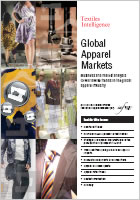Issue
3:
3rd Quarter 2008

Product Overview
Buy this Report now
Buy this Issue now
Subscribe
Download brochure (PDF)
Download price list (PDF)
Price list download
| Please choose your preferred currency:
|
Request sample issue
View list of reports
in other issues
|
Multi Report Package |
We also offer a flexible subscription product,
the Multi Report Package,
which allows you to select your own choice of reports from our full range,
to suit your own budget.
Click here for full details.
|
|
 |
Textiles and clothing: opportunities for recycling |

20 pages,
published in Issue 3, 3rd Quarter 2008
Report price:
Euro 395.00;
US$ 520.00
|
Recycling in the textile and clothing sector can take several forms. The best known method involves the manufacture of a textile or clothing product from recycled consumer waste?such as plastic bottles or waste polyester yarns or fabrics. Other forms involve the reuse of waste textile and clothing products in a way which avoids throwing the items away, such as: shredding the products into fibres for sound insulation; redistributing the items in the form of second-hand clothing via charity shops or textile merchants (also known as rag collectors); and reusing fabrics for ?eco-fashion?.
Recycling in the textile and clothing industry offers companies important benefits, particularly from an environmental viewpoint. However, only a handful of prominent international textile and clothing companies are heavily involved in recycling. Examples of these firms are: USA-based Jimtex Yarns, a producer of recycled eco-friendly fibres and yarns and part of USA-based Martex Fiber Southern Corporation; Japan-based Teijin Fibers; USA-based Unifi, which is the owner of the Repreve brand of yarns made from 100% recycled materials; the USA-based clothing producer American Apparel; the UK-based apparel retailer Marks & Spencer (M&S); the USA-based outdoor apparel producer Patagonia; the USA-based fleece fabric maker Polartec; the Japan-based clothing retailer Uniqlo; and the USA-based retailer Wal-Mart.
To encourage recycling in the EU, new legislation came into force on December 12, 2008, in the form of a revised Waste Framework Directive (WFD). The revised directive, which aims to make it easier for EU citizens and corporations to recycle, has nominated textiles as a ?priority waste stream? because the recycling of textiles is deemed to bring with it significant environmental and economic benefits. The next step for the EU is to decide upon an EU-wide definition of the exact stage of the refuse process at which discarded textile products cease to become waste and, instead, become materials to be recycled.
Companies which are interested in getting more involved in textile and clothing recycling can take comfort from the fact that textile recycling is well supported commercially by numerous industry associations?and politically by government initiatives in many of the world?s largest economies.
In addition, there are plenty of non-governmental organisations (NGOs) involved in textile recycling, such as UK-based Textile Recycling for Aid and International Development (TRAID) and the Goonj project in India.
|
 |
